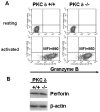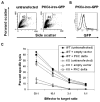Protein kinase Cdelta regulates antigen receptor-induced lytic granule polarization in mouse CD8+ CTL
- PMID: 17548619
- PMCID: PMC3712856
- DOI: 10.4049/jimmunol.178.12.7814
Protein kinase Cdelta regulates antigen receptor-induced lytic granule polarization in mouse CD8+ CTL
Abstract
Lytic granule exocytosis is the major pathway used by CD8+ CTL to kill virally infected and tumor cells. Despite the obvious importance of this pathway in adaptive T cell immunity, the molecular identity of enzymes involved in the regulation of this process is poorly characterized. One signal known to be critical for the regulation of granule exocytosis-mediated cytotoxicity in CD8+ T cells is Ag receptor-induced activation of protein kinase C (PKC). However, it is not known which step of the process is regulated by PKC. In addition, it has not been determined to date which of the PKC family members is required for the regulation of lytic granule exocytosis. By combination of pharmacological inhibitors and use of mice with targeted gene deletions, we show that PKCdelta is required for granule exocytosis-mediated lytic function in mouse CD8+ T cells. Our studies demonstrate that PKCdelta is required for lytic granule exocytosis, but is dispensable for activation, cytokine production, and expression of cytolytic molecules in response to TCR stimulation. Importantly, defective lytic function in PKCdelta-deficient cytotoxic lymphocytes is reversed by ectopic expression of PKCdelta. Finally, we show that PKCdelta is not involved in target cell-induced reorientation of the microtubule-organizing center, but is required for the subsequent exocytosis step, i.e., lytic granule polarization. Thus, our studies identify PKCdelta as a novel and selective regulator of Ag receptor-induced lytic granule polarization in mouse CD8+ T cells.
Conflict of interest statement
The authors have no financial conflict of interest.
Figures





Similar articles
-
Protein kinase C delta localizes to secretory lysosomes in CD8+ CTL and directly mediates TCR signals leading to granule exocytosis-mediated cytotoxicity.J Immunol. 2008 Oct 1;181(7):4716-22. doi: 10.4049/jimmunol.181.7.4716. J Immunol. 2008. PMID: 18802074
-
Activation of primary T lymphocytes results in lysosome development and polarized granule exocytosis in CD4+ and CD8+ subsets, whereas expression of lytic molecules confers cytotoxicity to CD8+ T cells.J Leukoc Biol. 2006 Oct;80(4):827-37. doi: 10.1189/jlb.0603298. Epub 2006 Aug 4. J Leukoc Biol. 2006. PMID: 16891618
-
Ganglioside inhibition of CD8+ T cell cytotoxicity: interference with lytic granule trafficking and exocytosis.J Immunol. 2012 Oct 1;189(7):3521-7. doi: 10.4049/jimmunol.1201256. Epub 2012 Sep 5. J Immunol. 2012. PMID: 22956583
-
Mechanistic, functional and immunopharmacological implications of biochemical studies of antigen receptor-triggered cytolytic T-lymphocyte activation.Immunol Rev. 1988 Mar;103:127-60. doi: 10.1111/j.1600-065x.1988.tb00754.x. Immunol Rev. 1988. PMID: 3134292 Review.
-
Calcium influx and signaling in cytotoxic T-lymphocyte lytic granule exocytosis.Immunol Rev. 2009 Sep;231(1):160-73. doi: 10.1111/j.1600-065X.2009.00809.x. Immunol Rev. 2009. PMID: 19754896 Review.
Cited by
-
Signal Transduction in Immune Cells and Protein Kinases.Adv Exp Med Biol. 2021;1275:133-149. doi: 10.1007/978-3-030-49844-3_5. Adv Exp Med Biol. 2021. PMID: 33539014
-
Role of Actin Cytoskeleton Reorganization in Polarized Secretory Traffic at the Immunological Synapse.Front Cell Dev Biol. 2021 Feb 4;9:629097. doi: 10.3389/fcell.2021.629097. eCollection 2021. Front Cell Dev Biol. 2021. PMID: 33614660 Free PMC article. Review.
-
Formin-like 1β phosphorylation at S1086 is necessary for secretory polarized traffic of exosomes at the immune synapse in Jurkat T lymphocytes.Elife. 2024 Oct 31;13:RP96942. doi: 10.7554/eLife.96942. Elife. 2024. PMID: 39479958 Free PMC article.
-
Intra- and Extracellular Effector Vesicles From Human T And NK Cells: Same-Same, but Different?Front Immunol. 2021 Dec 23;12:804895. doi: 10.3389/fimmu.2021.804895. eCollection 2021. Front Immunol. 2021. PMID: 35003134 Free PMC article. Review.
-
Cutting Edge: Murine NK Cells Degranulate and Retain Cytotoxic Function without Store-Operated Calcium Entry.J Immunol. 2017 Sep 15;199(6):1973-1978. doi: 10.4049/jimmunol.1700340. Epub 2017 Aug 9. J Immunol. 2017. PMID: 28794231 Free PMC article.
References
-
- Russell JH, Ley TJ. Lymphocyte-mediated cytotoxicity. Annu Rev Immunol. 2002;20:323–370. - PubMed
-
- Kagi D, Ledermann B, Burki K, Zinkernagel RM, Hengartner H. Molecular mechanisms of lymphocyte-mediated cytotoxicity and their role in immunological protection and pathogenesis in vivo. Annu Rev Immunol. 1996;14:207–302. - PubMed
-
- Berry M, Bleackley R. Cytotoxic lymphocytes: all roads lead to death. Nat Rev Immunol. 2002;2:401–409. - PubMed
-
- Blott EJ, Griffiths GM. Secretory lysosomes. Nat Rev Mol Cell Biol. 2002;3:122–131. - PubMed
-
- Lancki DW, Weiss A, Fitch FW. Requirements for triggering of lysis by cytolytic T lymphocyte clones. J Immunol. 1987;138:3646–3653. - PubMed
Publication types
MeSH terms
Substances
Grants and funding
LinkOut - more resources
Full Text Sources
Other Literature Sources
Molecular Biology Databases
Research Materials

